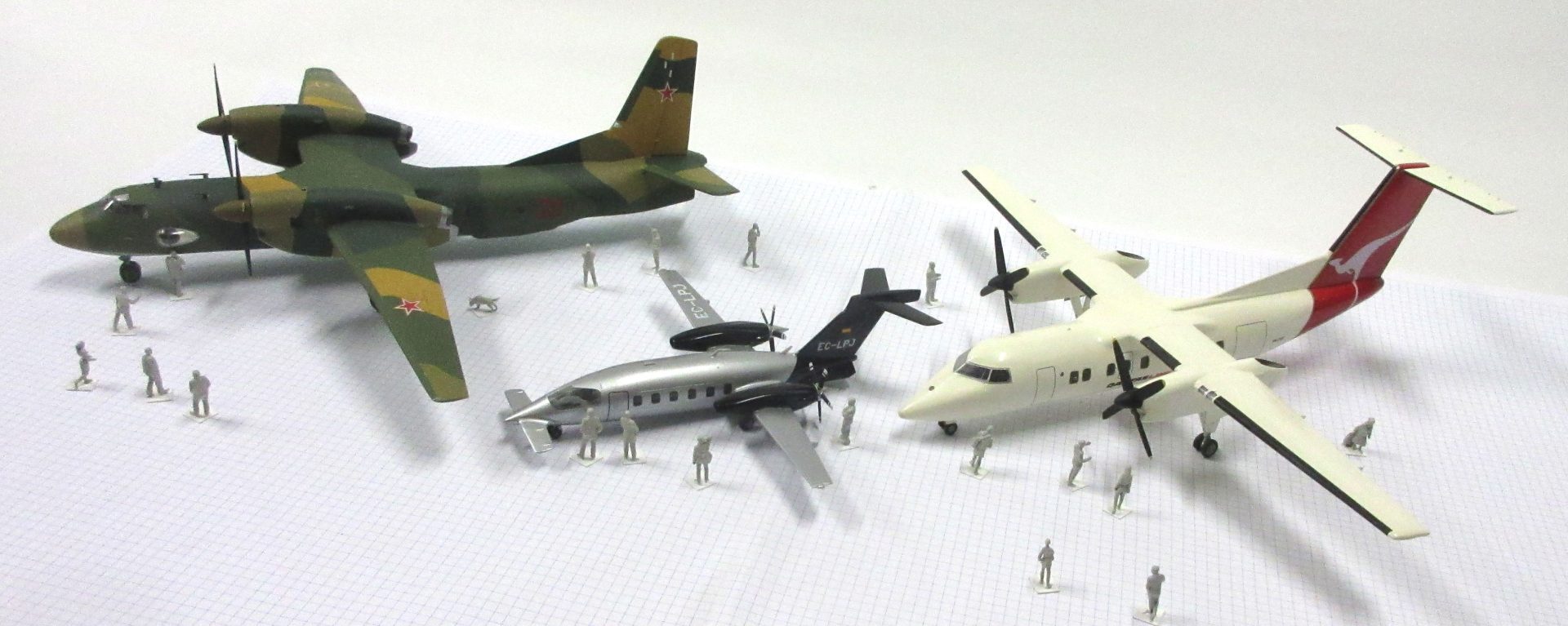Turboprop Twins
Antonov An-32 – deHavilland Canada Dash-8-100 – Piaggio P180 Avanti
 Turboprop engines occupy the space in aero engines between piston engines and pure just aircraft and generally also fit into the range between small aircraft and larger ones. If you’re looking for speed and altitude you need pure jet aircraft and if you’re looking for a smaller, slower and lighter aircraft then piston engines are for you. The turboprop offers higher speed than piston engines and cheaper operating costs than pure jet engines. You will see turboprop powered aircraft at most airports where they are often used by regional airlines and charter operators. There are also many turboprop military aircraft including, for example, most primary trainers. Today, however, let’s look at three twin engined turboprop aircraft.
Turboprop engines occupy the space in aero engines between piston engines and pure just aircraft and generally also fit into the range between small aircraft and larger ones. If you’re looking for speed and altitude you need pure jet aircraft and if you’re looking for a smaller, slower and lighter aircraft then piston engines are for you. The turboprop offers higher speed than piston engines and cheaper operating costs than pure jet engines. You will see turboprop powered aircraft at most airports where they are often used by regional airlines and charter operators. There are also many turboprop military aircraft including, for example, most primary trainers. Today, however, let’s look at three twin engined turboprop aircraft.
Antonov An-32 in 1/72 by Amodel
This aircraft is a version of the earlier Antonov An-26 transport aircraft which is, in turn, a version of the Antonov An-24 airliner that was produced in the Soviet Union between 1959 and 1979. The An-26 and An-32 were designed as cargo transports with rear loading ramps but the An-32 was designed to withstand adverse weather conditions better than the An-26 with improved wings and much more powerful engines to improve its take-off performance and service ceiling. They are used in both civil and military roles. Production began in 1982 and they remain in production with almost 400 having been built so far.
I made this model using the Amodel 1.72 kit of the AN-32. It comes with four livery options including this USSR military one. Amodel also offer an An-32B which comes only in Aeroflot livery. The An-32 kit was published in 2006 and the An-32B in 2012, I found this a difficult kit to make, partly because it has a multiplicity of smaller parts that often don’t line up properly so the whole things needs a lot of filling and filing to get something that looks aerodynamic. If you want to see a much better build of this kit than mine have a look at the review on iModeler.com and if you want to see why making this model is a serious challenge have a look at this YouTube video titled ‘A Difficult Build Part-1‘.
DeHavilland Canada Dash-8-100 by Hobbycraft
This aircraft is the first version of the popular Dash-8 series of airliners that has served regional airlines around the world, beginning in 1984 with the Dash-8-100 series. Whereas later Dash-8s have longer fuselages and can accommodate up to 90 passengers this first version had a passenger capacity of 37-40 passengers. Over 1,2500 Dash-8s have been manufactured and over 130 have been registered in Australia, 46 of them the Dash-8-100 series. They were used by several regional airline companies including Sunstate, Southern Australia Airlines and Eastern Australia Airlines which combined operations under the QantasLink brand in the 2000s.
The Hobbycraft kit from which this model was built is not a pleasant thing to contemplate or try to make an acceptable model from. However, it is the only kit available of this aircraft. It was first published in 1990 and has been republished several times by Hobbycraft, Platz and Kitech. The Modelling Madness review does not quite say that this is not a good kit, but you can read between the lines. There is also some discussion of the problems with this kit on a Britmodeller forum that might be useful. For me the equation was very simple, this is the only Dash-8 kit in this scale so I did the best I could with it.
Piaggio P180 Avanti in 1/72 by Amodel
This aircraft is a turboprop powered business aircraft which differs from other similar aircraft in having pusher engines rather than the conventional tractor configurations which reduced the drag created by the engine pods. This follows on from the earlier Piaggio P166 which also had pusher engines. The Avanti’s highly refined streamline design makes it faster and more fuel efficient than most turboprop aircraft in its class. It’s target market was Fortune 500 companies looking for an efficient and elegant looking aircraft.
I made this model using the Amodel kit that was first published in 2015. It is a challenge to make, like all Amodel kits I’ve made, but the end result can turn out okay if you stick with it and work at getting each stage of the process as neat and tidy as you can. I think that I only stuck with this model to the end was because I liked the shape of the Avanti and wanted one in my collection. There is also a Cunarmodel kit published earlier that might, or might not, be easier to make, but I haven’t seen one or seen a review of one so I don’t know about it. There was also a Sanger vacformed kit published in the 1990s which is not recommended for beginners in the Modelling Madness review.



